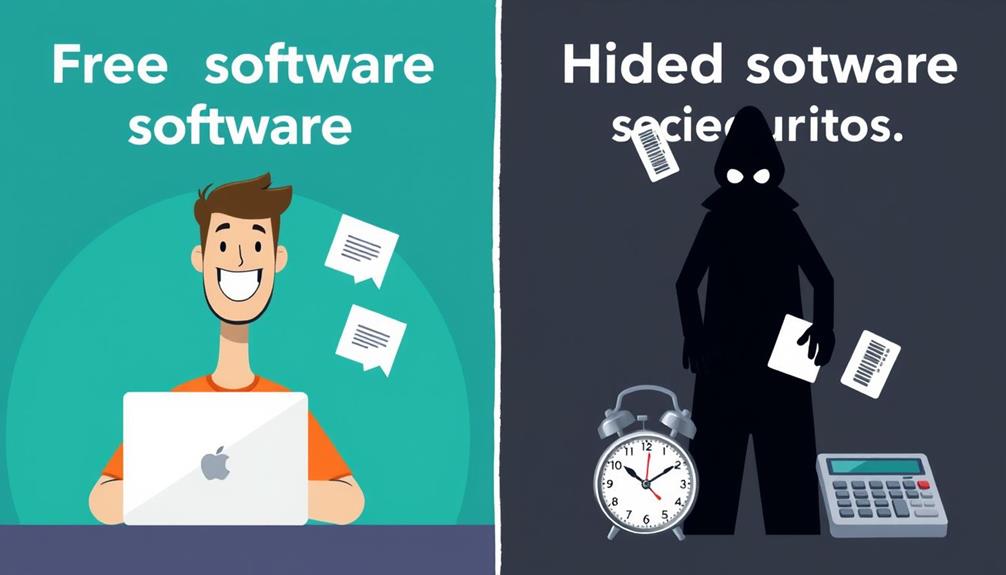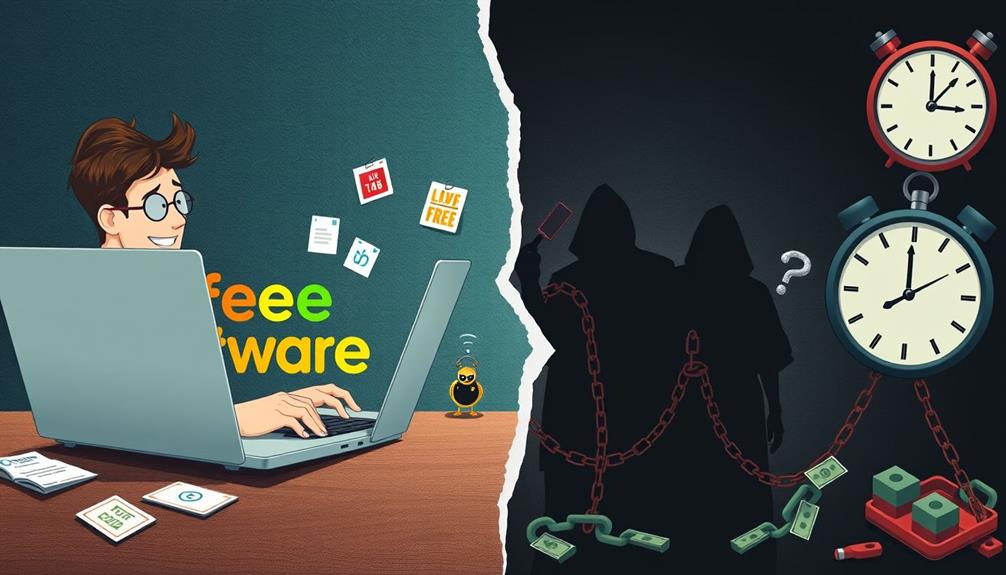Free software, like Linux and LibreOffice, might seem cost-effective initially, but it's not truly free when you consider hidden costs. You may face expenses for installation, maintenance, and support. There's also the risk of data privacy issues and security vulnerabilities that can lead to costly repercussions. Time spent troubleshooting can detract from productivity and innovation, further increasing opportunity costs. Additionally, you might have to invest in training your team to use these tools effectively. Understanding these factors helps you make informed decisions about software choices, and there's more to uncover about the true implications of using free software.
Key Takeaways
- Free software may be free to download, but hidden costs like maintenance, support, and compliance can accumulate over time.
- Lack of regular updates and security patches in free software increases vulnerability to cyber attacks and data breaches.
- Time spent troubleshooting free software can detract from innovation and reduce overall employee productivity.
- Legal and compliance challenges associated with open-source software may result in unexpected legal costs and fines.
- Unknown contributors in free software projects can introduce vulnerabilities, necessitating additional security measures to mitigate risks.
Understanding Free Software
When exploring free software, it's vital to grasp what "free" really means. Many assume it comes without costs associated, but that's not always the case. Free software, like Linux, GIMP, and LibreOffice, is often available at no monetary charge. However, you might still face expenses in other areas, such as installation, ongoing maintenance, or technical support.
Additionally, understanding the importance of budgeting for software needs can help you anticipate potential costs that may arise from using free software.
Understanding the terms of use is essential, as these can dictate limitations on functionality or even impose obligations if you modify the software. While you're saving money initially, consider the potential costs of troubleshooting or securing your data, especially if the software lacks regular updates.
Moreover, risks like data privacy concerns and security vulnerabilities can arise, primarily when you rely on free software without adequate support. By being aware of these factors, you can make informed decisions about whether free software is genuinely free for your specific needs.
Hidden Costs Overview

When using free software, you need to take into account the hidden costs that often come into play.
You might face data privacy risks and security vulnerabilities, which can lead to expensive remediation efforts. Additionally, the time you spend troubleshooting these issues can slow down your projects and hinder your business growth.
It's essential to be aware of potential cold medications side effects that could arise if you rely heavily on unsupported software solutions for health-related tasks.
Data Privacy Risks
Free software often seems like a great deal, but hidden data privacy risks can turn that bargain into a costly mistake. When you use free software, you might unknowingly expose yourself to significant threats regarding your personal information.
Here's what you need to keep in mind:
- Data collection: Many free applications gather user data, which could be sold to third parties without your consent. This is particularly concerning as email and communication security remain critical in protecting personal information.
- Lack of security: These programs often lack robust security measures, making them susceptible to data breaches that can compromise your sensitive information.
- Invasive terms: Lengthy terms of service agreements can lead you to consent to invasive data collection practices, often without realizing it.
- Irregular updates: The absence of regular updates leaves vulnerabilities unpatched, increasing risks of exploitation by malicious actors.
In this landscape, limited customer support makes it even harder for you to get assistance during a security incident.
As you weigh the benefits of free software, remember that these data privacy risks can have lasting repercussions on your personal information and overall trust.
Security Vulnerabilities
Maneuvering the landscape of free software means confronting a myriad of security vulnerabilities that can come back to haunt you.
Unlike proprietary software, free software often lacks regular updates and security patches, leaving your systems open to exploitation by cyber attackers. In an era where AI's role in enhancing user experience is becoming increasingly important, the absence of consistent support can put your organization at risk. Without dedicated support, you might find yourself in a precarious position during a security incident, unable to access immediate assistance.
Open-source projects can have unknown contributors, which increases the risk of malicious code sneaking in unnoticed. Since many free software projects don't undergo thorough auditing, these security vulnerabilities can remain undetected for long stretches, potentially leading to severe security breaches.
Additionally, if you're using free software in your organization, you may face hidden costs from managing security breaches and compliance issues, especially if you fail to meet industry standards.
These vulnerabilities not only threaten your data but can also impact your organization's reputation and bottom line.
In short, while free software might seem enticing, the hidden costs tied to security vulnerabilities are something you can't afford to overlook.
Opportunity Costs
While security vulnerabilities can pose substantial risks, the hidden opportunity costs tied to free software often go unnoticed. When you choose free software, you're not just saving money upfront; you're also investing time and resources that could be spent on more productive activities. This diversion can lead to project delays and hinder your team's focus on core business activities.
In a similar vein, the importance of choosing solutions that integrate seamlessly with your existing systems can't be understated, especially as seen in energy-efficient appliances that enhance overall home performance.
Consider these opportunity costs:
- Time spent troubleshooting instead of innovating.
- Decreased employee productivity as they learn to navigate free software.
- Potential future costs from needing to switch to paid solutions.
- Impact on morale as frustration with the software accumulates.
These factors can greatly affect your organization's performance. You might find that the long-term implications of using free software, such as compatibility issues and lack of support, outweigh any initial savings.
It's essential to evaluate whether the immediate benefits are worth the hidden costs that could emerge down the line. Ultimately, the opportunity cost of choosing free software may be far greater than you initially anticipated.
Legal and Compliance Issues

Maneuvering the landscape of open source software brings with it a unique set of legal and compliance challenges that can catch many organizations off guard. While the software itself may be free to download, you'll quickly realize that legal costs associated with evaluating and ensuring compliance with various licenses can stack up.
In the same vein, organizations should be aware of the potential risks associated with IRA rollovers to gold, which can also lead to unforeseen legal complications. Copyleft licenses, for instance, require you to contribute any modifications back to the community, which can complicate your proprietary development efforts and lead to unexpected legal obligations.
Moreover, non-compliance with open source licenses can expose your organization to significant legal risks, including potential litigation and hefty fines. These issues don't just threaten your budget but can also derail projects, leading to delays and increased operational costs.
Since many open source projects lack proper auditing mechanisms, identifying security vulnerabilities becomes challenging, heightening the risk of cybersecurity threats, especially in regulated environments.
Ultimately, it's vital to navigate these legal and compliance waters carefully, as overlooking these aspects can lead to unforeseen consequences that far outweigh the perceived savings of using free software.
Development and Maintenance Costs

When you consider free software, it's easy to overlook the ongoing maintenance expenses that come with it.
These costs can be significant, especially when you factor in the need for keyword optimization to guarantee your software remains relevant in a competitive landscape.
You might find yourself allocating more development resources than expected, especially for updates and custom features.
These hidden costs can quickly add up, raising questions about the true affordability of free software.
Ongoing Maintenance Expenses
In the long run, ongoing maintenance expenses for free software can catch organizations off guard. While the initial download may be free, the real cost often surfaces through hidden expenses.
You might find yourself spending more time and money than anticipated on various aspects of maintenance, including:
- Bug fixes that require ongoing development efforts.
- Security patches that demand immediate attention and resources.
- Customization needs that integrate the software into your existing systems.
- Staff training to guarantee effective use and reduce errors.
Additionally, just like investing in a Gold IRA, where understanding the transparent fee structure is vital, free software can have its own set of hidden costs that must be accounted for.
The lack of dedicated support in free software can lead you down a rabbit hole of troubleshooting, where your team invests significant time on issues that could have been avoided.
Furthermore, without formal training programs, inefficiencies can arise, further inflating those ongoing maintenance expenses.
When you tally up all these factors, the cumulative effect often leads to the total cost of ownership for free software surpassing that of paid alternatives.
Development Resource Allocation
Ongoing maintenance expenses aren't the only financial concern with free software; development resource allocation is just as critical. When you adopt free software, you often need to devote significant internal resources to develop and maintain it. This means allocating personnel for tasks like coding, bug fixing, and system updates, which can quickly lead to costs that overshadow your initial savings.
Additionally, as organizations increasingly rely on technology, there's a growing demand for roles like AI Software Engineer Jobs to oversee the development and integration of such systems.
Hidden costs may also emerge from the need for additional features and customizations, resulting in unplanned expenditures and extended timelines. Without dedicated vendor support, your organization might face ongoing management costs, forcing you to hire external experts for effective use and maintenance.
Moreover, the complexity of free software can demand extensive time investments for training and onboarding, diverting your team's focus from core business activities and leading to opportunity costs.
As your organization grows, long-term maintenance can incur further costs, especially as scalability demands increase. This necessitates extra development resource allocation for licenses, updates, and security measures, making it clear that "free" software isn't always free in the long run.
Support and Resources Required

Maneuvering the world of free software can be a double-edged sword, especially when it comes to support and resources. While you might save on upfront costs, the hidden expenses can quickly add up. It’s important to carefully consider the long-term implications of free software, as well as the potential impact on your net worth. Seeking out reliable sources for support and guidance, such as user forums and online communities, can help uncover net worth secrets and valuable insights. By taking the time to fully understand the true cost and potential limitations of free software, you can make informed decisions that align with your financial goals.
Often, free software lacks dedicated support, making troubleshooting a challenge. You may find yourself relying on community forums or self-help resources, which can be time-consuming. Additionally, understanding the financial considerations for elder care can offer insights into the importance of investing in reliable tools and services that guarantee efficient management.
Consider the potential costs associated with support:
- Training Needs: You might require extensive training to get up to speed.
- Time Investment: Learning curves can lead to decreased productivity and errors.
- Compatibility Issues: Integrating free software with existing systems may necessitate workarounds.
- External Services: You may need to invest in external support services, further driving up costs.
Without timely updates and security patches, you could also face cybersecurity vulnerabilities, prompting additional investments in protection measures.
Ultimately, while free software might seem appealing at first glance, the lack of robust support could lead to unforeseen challenges that affect your organization's efficiency and budget.
Security Vulnerabilities

When you use free software, you might notice it often lacks regular updates, leaving you vulnerable to security threats.
The anonymity of contributors can also pose risks, as you can't always trust their intentions or expertise.
This makes it essential to reflect on how these factors could impact your data security and privacy.
Lack of Regular Updates
In today's rapidly evolving digital landscape, the lack of regular updates in free software poses substantial security risks. While you might think you're saving money by using free software, you're often overlooking the hidden costs of free. The absence of prompt updates can leave your systems vulnerable to newly discovered threats. A staggering 70% of open-source projects lack dedicated teams for security updates, meaning vulnerabilities can linger for far too long.
Consider these risks:
- Critical vulnerabilities left unpatched for over 100 days
- Increased chances of malicious code slipping through unknown contributors
- Potential compliance issues if your organization operates in regulated environments
- Reputational damage from security incidents stemming from outdated software
Without regular updates, you might find yourself exposed to attacks that could have been easily prevented. As a user, it's crucial to weigh the risks against the benefits.
The reality is that maintaining security in a free software environment often requires more vigilance and resources than you might initially anticipate. Don't let the allure of free software blind you to the significant security vulnerabilities that come with it.
Unknown Contributor Risks
The world of open source software can be a double-edged sword, especially when it comes to security vulnerabilities introduced by unknown contributors. These contributors may lack accountability, potentially leading to undetected flaws that malicious actors can exploit. A study by the Open Source Security Foundation found that over 80% of open source projects contain at least one vulnerability, showcasing the significant risk associated with unknown contributor risks.
To better understand the implications, consider the following table:
| Risk | Implications |
|---|---|
| Lack of accountability | Increased chances of undetected flaws |
| Absence of rigorous auditing | Vulnerabilities could go unnoticed |
| Compliance risks in regulated industries | Severe data protection implications |
Organizations using open source software must invest in additional security measures to mitigate these risks. This could include regular audits, implementing security tools, and maintaining a proactive approach to vulnerability management. Ultimately, understanding the risks associated with unknown contributors is essential for safeguarding your systems and data.
User Training and Productivity

Steering the world of free software can feel like steering a ship through stormy seas. You might find that the initial excitement gives way to challenges, especially regarding user training and productivity. Free software often comes with steep learning curves, which can slow you down during the shift. Without formal training programs, you're left to navigate community forums for help, and that can lead to frustration.
Consider these potential challenges:
- Time investment: You'll spend hours learning the ins and outs, cutting into your productivity.
- Complex interfaces: Adapting to new systems can feel overwhelming, affecting morale.
- Collaboration barriers: Incompatibility with commonly used software can create inefficiencies.
- Community support: Reliance on forums means help mightn't come when you need it most.
As you adapt, your productivity may take a hit, and that can have long-term implications. Over time, what started as a cost-saving measure might lead you to reconsider paid solutions to meet your evolving organizational needs.
Long-term Economic Implications

Often, organizations underestimate the long-term economic implications of using free software. While it may seem cost-effective initially, hidden costs can accumulate quickly. You might find yourself spending more on necessary upgrades, training, and support than you would on a paid solution. Additionally, opportunity costs arise as productivity dips due to troubleshooting issues and steep learning curves, which detracts from your core business activities.
Here's a breakdown of potential long-term costs associated with free software:
| Cost Type | Description |
|---|---|
| Upgrades & Support | Ongoing expenses to keep software functional |
| Productivity Loss | Time lost due to troubleshooting issues |
| Security Risks | Potential fines from data privacy breaches |
| Scalability Challenges | Costs incurred when moving to paid solutions |
The lack of dedicated support can lead to inefficiencies and increased downtime, potentially causing significant financial losses. As your organization grows, you might face unexpected costs if you need to shift to more robust, paid alternatives. Addressing these hidden costs early can save you from larger financial setbacks down the road.
Vendor Relationships and Negotiations

Establishing strong vendor relationships is essential for maximizing the benefits of free software. Open conversations with your vendors can clarify needs and expectations, leading to customized solutions tailored to your specific use cases.
By building these relationships, you enhance satisfaction and foster collaboration, allowing for valuable feedback that might result in product enhancements or new features.
Consider the following aspects to strengthen your vendor relationships:
- Engage in negotiations: This can lead to cost-effective agreements, including support and updates in upfront purchases.
- Utilize vendor expertise: Understanding the full scope of services offered guarantees thorough support and maintenance are factored into your agreements.
- Regular performance reviews: Keeping tabs on vendor accountability helps guarantee the software continues to meet your evolving organizational needs.
- Communicate regularly: Consistent dialogue with vendors allows for adjustments and improvements as your requirements change.
Total Cost of Ownership Analysis

When evaluating the value of free software, it's crucial to look beyond its initial appeal and consider the Total Cost of Ownership (TCO). The TCO for free software includes not just that enticing zero-dollar acquisition cost but also significant expenses tied to installation, configuration, maintenance, training, and ongoing support.
These costs can accumulate quickly over time, often exceeding what you might've spent on a paid solution. Additionally, hidden fees can emerge when you find that vital add-ons or premium features, necessary for full functionality, aren't entirely free.
You'll also want to factor in opportunity costs, as time spent troubleshooting and managing free software can detract from more productive tasks.
Security is another critical factor. Free software often lacks regular updates or formal support, which means you might need to invest in additional security measures to protect your data.
Conclusion
In summary, while free software might seem like a savvy solution, it's vital to take into account the concealed costs that can creep in. From compliance challenges to costly complexities in support, these hidden hurdles can hinder your hopes for hassle-free usage. By thoroughly evaluating the total cost of ownership, you can make informed decisions that truly benefit your bottom line. Don't let the allure of "free" cloud your judgment; instead, embrace an enlightened approach to software selection.










